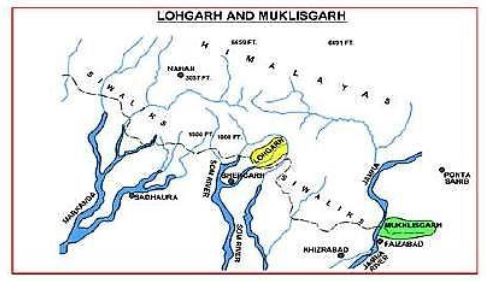Did Banda Singh change the name of Mukhlisgarh Fort to Lohgarh Fort
Dr Alka Mishra*
It has often been said that Banda Singh Bahadur captured Mukhlisgarh fort and renamed it as Lohgarh Fort. One historian says that Banda Singh built a fort near Mukhlisgarh village and named it Lohgarh1. In fact, there is no village known as Mukhlisgarh. We have maps drawn by Major James Rennel (1742-1830). He is known as the father of geography. In 1792, he published Memoirs: Maps of Countries between Delhi and Candahar. This book refers to Moklespore (Mukhlispur) “a place seven or eight kos from Sadhaura, near the northern hills and on the edge of a small hill, difficult of access, on which Islam Khan, son of Sher Khan Sur, in his day of brief authority, began to build a strong fortress, under the name of Pawagarh. It was left unfinished at his death, and, fell into ruins, part of which still remains. Banda Singh restored and extended these ruins.”2
1 Balwant Singh, Persian Sources on Banda Singh Bahadur, p 36.
2 Irvine, Later Mughals, vol. 1, p 109.
3 In February 1711, even the Mughal emperor Bahadur Shah stayed there and spent some time hunting in the hills.This has been referred to by Pancholi Jagjivan Das in his letter to the ruler of Jaipur.
In fact there is (nor ever was) any fort named Mukhlisgarh. This name was given to a palace which had been built as a holiday and pleasure resort for the kings and senior generals and governors, etc.3 It is about 30 kilometers away from Lohgarh and is on the eastern side of Yamuna river. It is not far from the Hathni Kund barrage. It has an area of 45 acres of land and the building of the palace covers an area of one and a half acre. Being in the foothills and on the bank of a river, it is a beautiful resort. The Mughal emperors used this palace for pleasure and hunting.
This palace has not a single feature of a fort; hence it is wrong to consider it as such. This area is known a Badshahi Bagh (royal garden) and the building is also known as Rang Mahal (place for pleasure). Irvine refers to this palace as “hunt-lodge, now called Badshahi Mahal, built by Shah Jahan, close to Jamuna Canals”. In 2017, the Archaeological Survey of India spent 20 million rupees to repair and renovate this building.
(See the location in the map):

1 Balwant Singh, Persian Sources on Banda Singh Bahadur, p 36.
2 Irvine, Later Mughals, vol. 1, p 109.
3 In February 1711, even the Mughal emperor Bahadur Shah stayed there and spent some time hunting in the hills.This has been referred to by Pancholi Jagjivan Das in his letter to the ruler of Jaipur.
*Dr Alka Mishra
Bareilly (India)